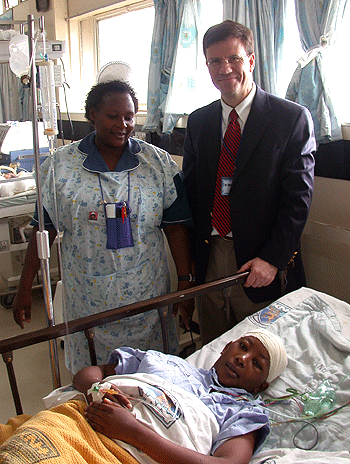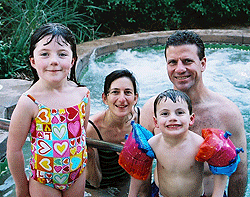Neurosurgery has a reputation for being a selective specialty. Cutting the brain is, after all, one of the gold standards by which less complicated tasks are dismissed: “It’s not brain surgery.”
It’s therefore not surprising that the ratio of U.S. brain surgeons to the general population is high: about one for every 150,000 people.
In the African nation of Ken-ya, though, that ratio is nearly an order of magnitude higher: 13 neurosurgeons for 30 million people, or about one to every 2.3 million people.
And that often has serious consequences in terms of delays that can turn highly treatable conditions into crippling or life-threatening disorders.
“In the United States, we mo-nitor and, when necessary, treat a tumor of the brain lining known as a meningioma,” says Michael Chicoine, M.D., associate professor of neurological surgery. “In Kenya, patients with this condition often end up blind or paralyzed because they weren’t diagnosed and treated soon enough.”

Chicoine belongs to an informal group of St. Louis health-care professionals who travel to Kenya semi-regularly on their own time and budget to help, performing surgeries and other procedures and aiding and encouraging the development of Kenyan neurosurgeons. He went back with the group this past fall for his third trip, a 10-day visit.
Paul Young, M.D., clinical professor in neurosurgery and anatomy at Saint Louis University, started the group.
“In Africa, you have to be very patient because things don’t quite work the same in hospitals over there as they do over here,” Young says with a gentle chuckle. “Mike is very well-liked by everybody in Africa because he’s very patient, soft-spoken, very generous with his time and is an absolutely fascinating teacher.”
Young points out that Chi-coine’s father died while Chicoine was on his first African trip with the group.
“It really says something about him that he continues to go back despite having that experience on the first trip,” Young notes.
In addition to bringing their expertise and services, participants bring much-needed medical supplies.
“Whenever we go, we minimize our own baggage so we can pack shunts, surgical supplies and things like that which are needed at African hospitals,” Chicoine says.
Chicoine and his colleagues do what they can to put small dents in the long waiting-room lines, but they recognize that the best way to alleviate those lines is to help train Kenyan neurologists, neurosurgeons and nurses.
He helped organize a multi-national program for training neurosurgeons, and on its most recent trip, the group put together a neuroscience research seminar.
“Making a difference in the lives of patients who might not otherwise get to see a doctor for some time is, of course, quite rewarding,” Chicoine says. “But the longer-term reward is to advance Africans’ ability to provide their own higher levels of neurosurgical care.”
Suited for surgery
Born in Chicago and raised in its northern suburbs, Chicoine, 42, is a friendly, easily approachable physician who recalls the selection of his medical specialty as the natural end-product of the development of his personal interests. The brain fascinated him in medical school, and he thought his personal talents were better suited for surgery.
After earning a medical degree at the University of California, Los Angeles in 1990, Chicoine came to the School of Medicine to complete an internship in general surgery and residency in neurosurgery. Outside of a one-year fellowship in 1997 at Good Samaritan Hospital and the University of Cincinnati School of Medicine, he has been here ever since.
Chicoine’s hobbies include running, golf, skiing and activities with his wife, Caroline, an intellectual property lawyer, and children Grace, 5, and Nicolas, 4.

He confesses amazement at how long he’s been in St. Louis.
“It’s astonishing how easy it has been to stay: Our chair, Ralph Dacey, has been very flexible in letting me develop my career in ways I choose, and I am able to see such a breadth of patients with complex problems,” he explains. “Also, I can collaborate with other researchers from many different specialties to develop and apply innovative treatments.”
Chicoine’s laboratory research interests include potential new cancer-treatment strategies based on the anti-tumoral effects of a common chemical compound known as lipopolysaccharide. Found in the cell membranes of some bacteria, lipopolysaccharide activates other molecules that can change the activity levels of a cell’s genes. In animal experiments, scientists have found this makes lipopolysaccharide a potent killer of tumor cells.
Chicoine also has several basic research initiatives, most of which center on questions related to the biology of brain tumor development and spread. One area of interest is gliomas, tumors that arise from brain support cells known as astrocytes.
“When gliomas evolve to their most malignant varieties, our ability to treat them is still somewhat limited,” he says. “In a worst-case scenario, a grade 4 glioma can take someone’s life in six to 12 months.”
To learn more about the invasive abilities of gliomas, during his residency, Chicoine used time-lapse video microscopy to make movies of the tumors as they spread through surrounding cell cultures.
He also has cultured a wide range of brain tumor samples, keeping about 250 of the samples alive in the lab so their differences from normal brain cells can be studied and tested against new treatments.
Above and beyond
One of Chicoine’s surgical specialties, surgery of the skull base, requires extensive multidisciplinary collaboration. Noting that the skull base “is a border zone that crosses several different areas of expertise,” Chicoine takes a human skull from a shelf in his office to illustrate.
|
Michael Chicoine Family: Wife, Caroline; daughter, Grace, 5; son, Nicolas, 4. Born: Chicago Education: B.S., biology, summa cum laude, Phi Beta Kappa, University of Illinois; M.D., University of California, Los Angeles University position: Associate professor of neurological surgery Favorite family activities: Visiting the Saint Louis Zoo, hiking, swimming, trips to Disney World Favorite local places to dine with his wife: Chez Leon and Cafe Provencale |
Opening the skull, he highlights the many intricate openings and structures that permeate the bottom of the skull directly under the brain.
“Those are the passages where various nerves, arteries and veins enter and exit the brain,” he explains. “To treat tumors and other problems in this region, we often have to call for assistance from several different specialties, including neuroradiologists; ear, nose and throat surgeons; ophthalmological surgeons; and plastic surgeons.”
The complex operations can last as long as 10 to 16 hours, according to Chicoine’s surgical nurse, Lisa Nicoletti, who praises Chicoine’s dedication to communicating with patients and their families.
“I think he goes above and beyond,” she says. “He listens to his patients, he follows up on things, and he’ll look beyond the neurosurgical issue and treat the whole patient. And he always, always talks to family members.”
Ralph Dacey, M.D., the Henry G. and Edith R. Schwartz Professor of Neurological Surgery and head of the Department of Neurological Surgery, also praises Chicoine’s dedication to patient care.
“His work over in Africa is just a dramatic representation of the way he lives his whole life,” Dacey says. “He’s very, very considerate with his time and his hard work, and he’s just a wonderful person.”